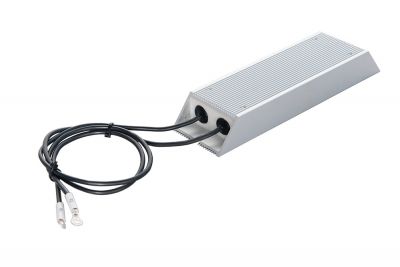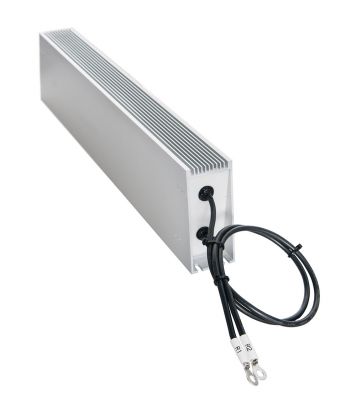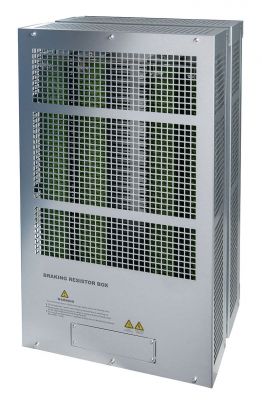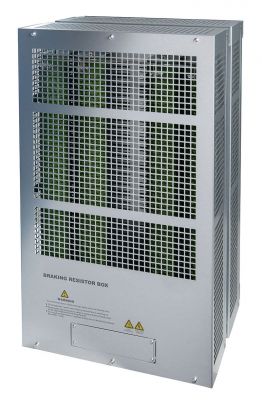Certified quality management system
Brake Resistors
The braking resistor STBR is ideal for the usage in drive systems with frequency inverter. During braking operation, the brake resistor converts a large amount of regenerative energy into thermal energy. Therefore a high load capacity and long life are very important. On resistance wire generated heat is quickly emitted via the extensive surface area of the high-density STBR braking resistor to the environment. The power consumption can be increased arbitrarily by variable series and parallel connection. In the selection of the brake chopper and brake resistor, there is to notice, that gearless systems feed back much more energy than systems with gear. Thus it is possible to feed back twice the energy at the same size of the drive. During the renovation of a facility it is essential to calculate the brake chopper and brake resistor design. The Sourcetronic braking resistors can be connected to the brake units STB 6014, STB 6024 and STB 6034 to achieve a higher resistance overall.
- Resistance: 750 Ω
- Rated power: 120 W (continuous braking power with appropriate heat dissipation)
- Operating voltage range: up to 400 V
- IP Grade: IP00/IP33
- Weather resistant and vibration resistant
- Easy insatallation
- Resistance: 400 Ω
- Rated power: 300 W (continuous braking power with appropriate heat dissipation)
- Operating voltage range: up to 400 V
- IP Grade: IP00/IP33
- Weather resistant and vibration resistant
- Easy insatallation
- Resistance Range: 250 Ω
- Rated power: 300 W (continuous braking power with appropriate heat dissipation)
- Operating voltage range: up to 400 V
- IP Grade: IP00/IP33
- Weather resistant and vibration resistant
- Easy insatallation
- Resistance: 150 Ω
- Rated power: 500 W (continuous braking power with appropriate heat dissipation)
- Operating voltage range: up to 400 V
- IP Grade: IP00/IP33
- Weather resistant and vibration resistant
- Easy insatallation
- Resistance Range: 100 Ω
- Rated power: 500 W (continuous braking power with appropriate heat dissipation)
- Operating voltage range: up to 400 V
- IP Grade: IP00/IP33
- Weather resistant and vibration resistant
- Easy insatallation
- Resistance: 75 Ω
- Rated power: 800 W (continuous braking power with appropriate heat dissipation)
- Operating voltage range: up to 400 V
- IP Grade: IP00/IP33
- Weather resistant and vibration resistant
- Easy insatallation
- Resistance Range: 50 Ω
- Rated power: 1000 W (continuous braking power with appropriate heat dissipation)
- Operating voltage range: up to 400 V
- IP Grade: IP00/IP33
- Weather resistant and vibration resistant
- Easy insatallation
- Resistance: 40 Ω
- Rated power: 1500 W (continuous braking power with appropriate heat dissipation)
- Operating voltage range: up to 400 V
- IP Grade: IP00/IP33
- Weather resistant and vibration resistant
- Easy insatallation
- Resistance: 25 Ω
- Rated power: 2000 W (continuous braking power with appropriate heat dissipation)
- Operating voltage range: up to 400 V
- IP Grade: IP00/IP33
- Weather resistant and vibration resistant
- Easy insatallation
- Power: 2.4 KW
- Resistance: 25 Ohm
- Max. current carrying capacity: 80A
- Voltage: <800V
- Temperature contact
- terminal: M6
- dimensions (W/H/D): 251/500/117 mm
- Weight: 7.3kg
- Power: 6.0 KW
- Resistance: 20 Ohm
- Max. current carrying capacity: 80A
- Voltage: <800V
- Temperature contact
- terminal: M6
- dimensions (W/H/D): 341/600/142 mm
- Weight: 12.5kg
- Power: 10.0 KW
- Resistance: 20 Ohm
- Max. current carrying capacity: 80A
- Voltage: <800V
- Temperature contact
- terminal: M6
- dimensions (W/H/D): 410.5/685/142mm
- Weight: 17.2kg
- Power: 10.0 KW
- Resistance: 14 Ohm
- Max. current carrying capacity: 80A
- Voltage: <800V
- Temperature contact
- terminal: M6
- dimensions (W/H/D): 410.5/685/142mm
- Weight: 17.2kg
Starting Resistors
The use of mounted starting resistors is quite similar. Here the brake resistors may be attached to the roof, resulting in the heat being dissipated; which provides sufficient cooling. In some types of locomotives the same results are achieved by fixing the starting resistors in the passenger compartments. Primarily used as brake resistors they are also used for temperature control in the winter, to keep the compartments warm. Modern vehicles combine the use of the braking resistors with a heat exchanger, which has the advantage that temperature regulation is not affected by the operation of the brakes.
Frequency Inverter and Brake Resistor
There has been research carried out over a long period of time to improve the braking resistors in order to achieve better results. For this reason frequency inverters and power settings are mostly used nowadays. The first one enables the conversion of current and the second one can be regulated to produce the maximum amount of power. This is achieved through the use of a thyristor. A better control of the current strength is achieved when the fluctuations in the mains supply are removed. During subsequent braking, power can be fed back into the mains supply. Resistors also feature in electromotive braking. They provide a considerable advantage as they allow safe breaking, even when there are connection problems with the mains network. The brake resistors work properly, but only under certain conditions. Primarily there is a need for constant cool air. In addition, the heated air must be able to vent freely. Also, when the ambient temperature reaches 40°C or more, it needs to be cooled. These criteria need to be maintained in all cases to avoid damage to the braking resistors and other components which may occur. To summarise, the brake resistor can be said to be making a major contribution to the smooth operation of machinery.
Brake Resistor Power
Calculation based on a 55 kW inverter:P = Q * Kc = 55 kW * 20% = 11 kWQ = motor powerKc = the ratio of energy recovery during engine operation (depending on load)
| Centrifuge | 05%-20% |
| Lifts | 10%-15% |
| Cranes (<100m) | 20%-40% |
| Oil Field Pumps | 10%-20% |
| Other | 10% |
Resistance Value
R = 2 * U / I = 2 * 670 V / 110 A = 12 ohmsU = operating voltage during brake application (DC link voltage)I = operatin current during brake application




